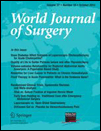Usefulness of Drain Amylase, Serum C-Reactive Protein Levels and Body Temperature to Predict Postoperative Pancreatic Fistula After Pancreaticoduodenectomy
Abstract
Background
Postoperative pancreatic fistula (POPF) after pancreaticoduodenectomy (PD) is a worrisome and life-threatening complication. Recently, early drain removal has been recommended as a means of preventing POPF. The present study sought to determine how to distinguish clinical POPF from non-clinical POPF in the early postoperative period after PD to aid in early drain removal.
Methods
From March 2002 through December 2010, 176 patients underwent PD and were enrolled in this study to examine factors predictive of clinical POPF after PD. POPF was defined and classified according to the International Study Group of Pancreatic Surgery guideline, and grade B/C POPF was defined as clinical POPF.
Results
Grade A POPF occurred in 39 (22.2 %) patients, grade B in 19 (10.8 %) patients, and grade C in 11 (6.3 %) patients. Clinical POPF (grade B/C) occurred in 17.1 % of patients. Multivariate analysis revealed male gender and body mass index (BMI) ≥22.5 kg/m2 to be the independent preoperative risk factors predictive of POPF. Receiver operating characteristic curves showed that the combination of drain amylase ≥750 IU/L, C-reactive protein (CRP) ≥20 mg/dL, and body temperature ≥37.5 °C on postoperative day 3 could effectively distinguish clinical POPF from non-clinical POPF. Sensitivity, specificity, and accuracy were 84.6, 98.2, and 95.7 %, respectively.
Conclusions
Male gender and BMI ≥22.5 were the independent preoperative predictive risk factors for POPF. We assume that when amylase is <750 IU/L, serum CRP is <20 mg/dL, and body temperature is <37.5 °C the drain can safely be removed, even if POPF is indicated.




